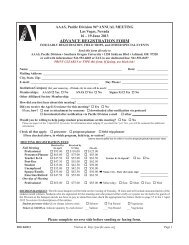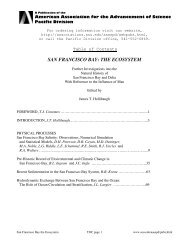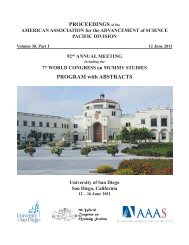Vol 31, Part I - forums.sou.edu ⢠Index page - Southern Oregon ...
Vol 31, Part I - forums.sou.edu ⢠Index page - Southern Oregon ...
Vol 31, Part I - forums.sou.edu ⢠Index page - Southern Oregon ...
You also want an ePaper? Increase the reach of your titles
YUMPU automatically turns print PDFs into web optimized ePapers that Google loves.
ABSTRACTS – Contributed Oral Papers<br />
temperatures were summarized to identify the first and last<br />
days of a 1500 growing-degree-day growing season. Precipitation<br />
was accumulated from the end of the growing season<br />
the previous year through <strong>31</strong> December, 1 January through<br />
the beginning of the current year growing season, and during<br />
the current growing season. These weather records were then<br />
subjected to principal components analysis. The eight years<br />
characterizing extremes in each of the five principal components<br />
were identified. Extreme year effects on calf growth<br />
were contrasted for each principal component. Irrespective<br />
of the pattern of precipitation before the growing season and<br />
with near or above average precipitation during the growing<br />
season, calves reared in years characterized by longer,<br />
cooler growing seasons gained more weight from birth to<br />
weaning than those reared in opposing years. This retrospective<br />
analysis indicates a general increase in temperature in<br />
the Northern Great Plains is expected to r<strong>edu</strong>ce the growth<br />
of calves from birth to weaning.<br />
MATHEMATICS<br />
Monday, starting at 10:30 a.m. in PONDEROSA PINES 1 & 2<br />
123 Perfect Stripes from a General Turing Model in Different<br />
Geometries, JEAN SCHNEIDER (Department of<br />
Mathematics, Boise State University, 1910 University Drive,<br />
Boise, ID 83725; jeanschneider@u.boisestate.<strong>edu</strong>).<br />
We explore a striped pattern generated by a general<br />
Turing model in three different geometries. We look at the<br />
square, disk, and hemisphere and make connections between<br />
the stripes in each spatial direction. In particular, we gain a<br />
greater understanding of when perfect stripes can be generated<br />
and what causes defects in their patterns. In this investigation<br />
we look at the difference between the solutions due<br />
to the different domain shapes. In the end we lay out a reason<br />
why stripes from a reaction-diffusion system can be perfect<br />
on a square or hemisphere, but can never be perfect on a disk.<br />
124 Markov Chains on the Symmetric Groups Converging to<br />
Non-uniform Measures, YUNJIANG JIANG (Department<br />
of Mathematics, Stanford University, building 380, Stanford,<br />
California 94305; yunjiangster@gmail.com).<br />
The study of random walks on finite groups, and in<br />
particular symmetric groups, viewed as card-shuffling models,<br />
has seen tremendous activities in recent decades. An<br />
extremely challenging set of problems concerns the mixing<br />
time in total variation as well as other distances on the space<br />
of probability measures. These problems have many practical<br />
consequences ranging from the effectiveness of Monte-<br />
Carlo simulation to number of times one needs to shuffle a<br />
deck of cards to mix it properly. Here we introduce several<br />
other important measures on the symmetric groups other<br />
than the uniform, construct natural Markov chains converging<br />
to them, and analyze their mixing times in sharp form<br />
84<br />
via results from symmetric function theory. We also introduce<br />
more general families of measures given by class functions,<br />
and analyze the associated Metropolis chains using<br />
the so-called path method. In particular we give a small<br />
degree polynomial bound for the uniform sampling chain on<br />
derangements, based on the random transposition walk. We<br />
will also mention a few open problems towards the end.<br />
125 Nondefective Secant Varieties of Split Varieties, DOUG-<br />
LAS A TORRANCE (Department of Mathematics, University<br />
of Idaho, 300 Brink Hall, Moscow, ID 83844; torrance@<br />
vandals.uidaho.<strong>edu</strong>).<br />
Suppose R is the polynomial ring in n+1 variables with<br />
coefficients in an algebraically closed field of characteristic<br />
zero k. The set of all homogeneous polynomials in R of<br />
degree d can be considered as a vector space over k. By considering<br />
two nonzero polynomials to be equivalent if they<br />
are scalar multiples of each other, we can define a projective<br />
space. The split variety, or variety of completely decomposable<br />
forms, consists of all points in this projective space<br />
which correspond to polynomials that are the product of d<br />
linear factors.<br />
For every s distinct points lying on this variety, there<br />
is an (s-1)-plane containing them. We define the closure of<br />
the union of all these (s-1)-planes as the secant variety. We<br />
expect that the secant variety of a split variety will either fill<br />
up the projective space or have dimension s(dn+1). In this<br />
case, the secant variety is said to be nondefective. Otherwise,<br />
it is said to be defective.<br />
It is conjectured that the secant variety to a split variety<br />
will be defective if and only if d = 2 and 2 ≤ s ≤ n/2. It<br />
remains to show that the remaining cases are nondefective.<br />
In this talk, we discuss new results in this area.<br />
Mathematics oral presentations continue on Tuesday.<br />
Please refer to <strong>page</strong> 90 in these Proceedings.<br />
CELL and MOLECULAR BIOLOGY<br />
Tuesday, starting at 8:40 a.m. in WILLOWS 2<br />
126 A Role for Inflammatory Cytokines in Breast Cancer<br />
Cell EMT, HUNTER COVERT*, NICOLE ANKEN-<br />
BRANDT, RANDY RYAN, and CHERYL JORCYK<br />
(Department of Biological Sciences, Boise State University,<br />
1910 University Drive, Boise, ID 83725; Huntercovert@u.<br />
boisestate.<strong>edu</strong>).<br />
Inflammatory cytokines are expressed in high levels during<br />
breast tumor development. Tumor cells, as well as monocytes,<br />
macrophages, and neutrophils, secrete these cytokines.<br />
Our preliminary results have shown certain inflammatory<br />
cytokines cause an increase in cell detachment as well<br />
as a change in morphology. The change in cell morphology<br />
can be studied by looking at cellular markers which are<br />
expressed when a cell displays an epithelial or mesenchymal








